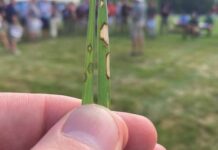Nematodes are detrimental turf pests found in golf course greens, fairways and tees across the United States. They are small, microscopic, unsegmented worms that feed on turfgrass roots, disabling their ability to take up water and nutrients. Nematodes can be devastating to root formation and overall turf health.
Though the worst of the summer weather is hopefully behind us, protecting fall root growth from nematodes is critical in both cool- and warm-season greens to help maximize performance through the winter and next year. In his latest Talking Turf blog, Bayer Green Solutions Team Specialist Zac Reicher shares tips for controlling nematodes this year.
Symptoms of nematode feeding
- Below ground: Reduced rooting, root lesions, root knots or root galls, excessive root branching, injured root tips and root rots (rot associated with bacteria and fungi)
- Above ground: Patchy yellowing, thinning, wilting, poor response to fertilizers and irrigation, and overall unhealthy turf despite adequate management inputs
Lab samples
- Laboratory diagnosis will confirm specie(s) and size of population(s), but labs vary widely in their threshold values for treatment
- Laboratory analysis can only help to determine that nematodes are involved in the symptoms but cannot confirm if they are the primary cause
Maximize cultural practices
- Reducing stress to create healthier turf will help minimize damage and maximize control
Control soil-borne diseases
- Pythium root rot, summer patch, take-all patch (creeping bentgrass), and take all root rot (warm-season grasses) will amplify damage from nematodes
Apply Indemnify® in the fall
- Improves root and shoot regrowth for both cool- and warm-season greens following summer stress and reduces nematode populations prior to winter, likely resulting in improved winter tolerance and spring turf response
- Provides curative and preventative control of plant parasitic nematodes including sting, root-knot, stunt, Anguina, and many more
- Easy to use with no need for excessive post-application irrigation, additional fungicides or wetting agents
What about lance nematodes?
- Lance nematodes are difficult to control and university nematologists agree that no current nematicide provides good control of lance nematodes. Indemnify controls all other nematodes to improve root health and make the plant more tolerant of lance nematodes

Spring results from a fall application of Indemnify on dwarf bermudagrass. (Photo: Tim Heirs, The Club at Mediterra)
Additional resources
- Green Solutions Update – Questions and Answers About Lance Nematodes
- Green Solutions Update – Indemnify BMP’s
Need more info? Read and follow all label directions. Contact your Bayer Area Sales Manager if you need assistance.

Zac Reicher, Ph.D. is a Green Solutions Team Specialist at Bayer. He is a former Turfgrass Specialist at Purdue University and University of Nebraska-Lincoln and has more than 34 years of turfgrass and horticultural experience. Reicher earned his Ph.D. in Agronomy/Turfgrass Science from Purdue University and his Master of Science in Horticulture/Turfgrass Science from Iowa State University











![[VIDEO] Dickies®: Discover Workwear That’s Anything But Uniform](https://turfmagazine.com/wp-content/uploads/2023/06/1647663814-4b1a2a7742790a9b1e97a3b963477850192e1d6a9dfba9b07214a77bae25d6e3-d-218x150.jpg)





























![[VIDEO] Dickies®: Discover Workwear That’s Anything But Uniform](https://turfmagazine.com/wp-content/uploads/2023/06/1647663814-4b1a2a7742790a9b1e97a3b963477850192e1d6a9dfba9b07214a77bae25d6e3-d-324x160.jpg)